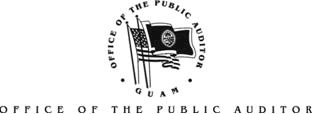
FY 2003 Financial Highlights
June 30, 2004
The Guam Department of Education (DOE) has issued its 2003 audited financial statements, prepared by Deloitte & Touche LLP, meeting the June 30, 2004 deadline imposed by the U.S. Department of Education (USDOE), the federal Single Audit Act and local law. While, DOE is now current in its submission of its annual audits to the USDOE, DOE must now begin to improve the quality of its audits, which includes obtaining a clean opinion and minimizing the number of audit findings and questioned costs. As part of the “high risk grantee” DOE is still required to submit quarterly grant reports.
The Auditors expressed a qualified opinion for FY 2003 because of a lack of records for fixed assets and non-appropriated funds. The same qualification was issued for the FY 2002 audit.
Single Audit ReportsThe Single Audit Report disclosed 25 findings for FY 2003, which resulted in questioned costs of $705,419. This is a decrease in the 28 findings reported in FY 2002 and a decrease of $189,009 in questioned costs from the previous year.
DOE’s unresolved questioned costs as of September 30, 2003, have increased to $9.2 million since FY 1998. Of this amount, $6.4 million is FEMA questioned costs from FYs 1998, 1999, 2000, and 2003. A year-by-year summary of the questioned costs is presented below:
Fiscal Year |
Total Questioned Costs |
FEMA Questioned Costs |
USDOE & Others |
1998 |
$1,692,928 |
$1,276,537 |
416,391 |
1999 |
3,468,809 |
3,130,222 |
338,587 |
2000 |
2,007,474 |
1,649,112 |
358,362 |
2001 |
397,550 |
----Zero---- |
397,550 |
2002 |
894,428 |
----Zero---- |
894,428 |
2003 |
705,419 |
304,047 |
401,372 |
Total |
$9,166,608 |
$6,359,918 |
$2,806,690 |
The FY 2003 USDOE & Others questioned costs is notably less than half of the previous year’s but FY 2003 FEMA questioned costs of $304,000 resulted entirely from procurement violations.
Another $330,580 in questioned costs came about because DOE did not obtain prior approval from the Special Education Cluster Program to purchase five passenger buses. A similar finding resulted in $339,470 questioned costs in FY 2002 for bus purchases. DOE has responded that they will send documents to the USDOE regarding the bus purchases for USDOE’s determination on resolving the finding.
Many of the FY 2003 audit findings were related to DOE’s lack of qualified accounting personnel. These repeat findings from FY 2002 included unrecorded transactions, no bank reconciliations, and no reconciliation of general ledger balances to the subsidiary ledgers. The Auditors recommended that DOE hire qualified accounting personnel to resolve these issues. DOE responded that they have hired a Comptroller as of June 1, 2004 and anticipate hiring qualified accountants by August 2004.
Other findings include:
- Non-Appropriated Funds (NAF) not properly accounted . This finding led to the DOE FY 2003 financial statements to receive a qualified opinion. The Auditors found that although this is a reiterative finding from FY 2002, there was no improvement in the quality of the accounting records at the schools and virtually no controls in place to safeguard the funds. The audit disclosed prohibited donations, no approvals for disbursements, and inadequate documentation of checks payable to individuals or checks for non-program related expenditures.
- Incomplete recording of fixed assets. This finding also contributed to the qualification of the FY 2003 financial statements. DOE was not able to provide a complete listing of all fixed assets. Equipment records are not maintained, physical inventory of equipment is not performed at least once every two years, and a property management system is not in place to account for asset acquisition and control.
- Inadequate documentation of procurement. A food supplies vendor was paid $169,454 although there were no procurement documents on file including a purchase order or contract.
- Federal Non-compliances . DOE was also cited for other noncompliance with the following requirements: eligibility, period of availability, reporting, and allowable activities.
- General Ledger not closed out and bank reconciliation not performed. General ledgers for fiscal years 2001, 2002, and 2003 remain open and will remain open until DOE posts the 2003 adjustments. Subsequently, the beginning balances of the FY 2004 ledgers will reflect accurate beginning balances. DOE has only performed bank reconciliations until FY 2001.
Total expenditures for FY 2003 were $184.8 million compared to $185.8 million in FY 2002, an decrease of $1 million. General fund appropriations were $138.1 million, compared to $138.5 million in prior year, a decrease of $400,000. Federal grants and program revenues were $39.8 million compared to $35.6 million an increase of $4.2 million. As a result DOE had an over-expenditure of $5.3 million compared to its $10.5 million over-expenditure in FY 2002.
DOE had total liabilities of $79.6 million, down from $86.6 million in 2002. Accrued expenses were $21.2 million, a significant drop from FY 2002’s $42.2 million partly due to DOE’s payment of its $24 million obligation to the Department of Revenue and Taxation for a levy issued in July 2003 for 2002 and 2003 withholding taxes, interest, and penalties. Interest and penalties were $6.8 million. Penalties of $2.3 million were abated in August 2003, however DOE still paid penalties of $3.3 million and interest of $1.2 million.
DOE has been current in its FY 2004 payments to GPA and the Government of Guam Retirement Fund, but payments are still due for prior years. The Retirement Fund is still owed approximately $20 million and GPA is owed approximately $13 million.
Other liabilities included Accounts Payable of $7.8 million and unfunded pension liability of $29.4 million.
DOE continues to make improvements to its financial management. A plan of action has been developed by DOE’s Fixed Asset Inventory Action Team to be completed by September 2005. DOE is in the process of requesting technical assistance from the Department of Interior through the Governor’s office for the development of a financial management improvement plan.